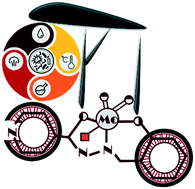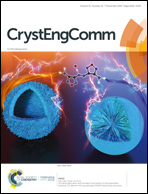Vapour- and solvent-mediated crystalline transformations in Mo(vi) hydrazone complexes controlled by noncovalent interactions†
Abstract
The synthesis and structures of the Mo(VI) coordination polymer [MoO2(L)]n (1), mononuclear complexes [MoO2(L)(MeOH)] (2α, 2β, and 2γ), and salts [MoO2(HL)(MeOH)]X, where X = Cl (3), Br (4), NO3 (5), and MeOSO3 (6), and L = 4-methoxysalicylaldehyde isonicotinoylhydrazonato ligand, are described. Polymer 1 can be quantitatively self-assembled from the neutral mononuclear complex upon vapour-mediated desolvation. The efficiency of the solid-state transformation is driven by the proximity of reaction centres due to O–H⋯N interactions. Additionally, the conversion seems to be sensitive to solvent polarity and can be achieved only in the presence of polar non-coordinating solvents. In the case of salts 3–6, an examination of the crystal structures shows that two architecturally different supramolecular assemblies are obtained. When anion X is Cl or Br, hydrogen bonded dimers are constructed while in the case of NO3 or MeOSO3 infinite hydrogen-bonded 1D chains are achieved. In the deprotonation reactions with Et3N, crystals of 3 or 4 and 5 or 6 serve as heteronuclear templates, affording polymorphic forms 2α and 2γ, respectively. A common feature of 2α and 2β forms is the association of the molecules into discrete dimers, whereas in the case of 2γ, 1D chains are formed as a consequence of O–H⋯N hydrogen bonding interactions. The non-porous complex 2α is shown to undergo a single-crystal-to-single-crystal transformation when crystals are exposed to moisture, thus yielding chains of hydrogen bonded dimers of [MoO2(L)(H2O)] (2w-α). The potent and broad-spectrum activity of 2–6 was established against selected Gram-positive and Gram-negative bacteria. The cytotoxicity of the compounds was evaluated on HepG2 and THP-1 cell lines.



 Please wait while we load your content...
Please wait while we load your content...